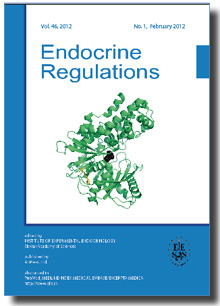Journal info
|
||
Select Journal
Journals
Bratislava Medical Journal Ekologia - Ecology Endocrine Regulations 2015 2014 2013 2012 2011 2010 2009 2008 2007 2006 2005 2004 2003 General Physiology and Biophysics Neoplasma Acta Virologica Studia Psychologica Cardiology Letters Psychológia a patopsych. dieťaťa Kovove Materialy-Metallic Materials Slovenská hudba 2025Webshop Cart
Your Cart is currently empty.
Info: Your browser does not accept cookies. To put products into your cart and purchase them you need to enable cookies.
Endocrine Regulations Vol.44, No.2, p.57-63, 2010 |
||
| Title: Thyrotropin versus thyroid hormone in regulating bone density and turnover in premenopausal women | ||
| Author: L. Baqi, J. Payer, Z. Killinger, P. Hruzikova, D. Cierny, K. Susienkova, P. Langer | ||
| Abstract: Objective. This cross-sectional study aimed to evaluate the interrelations between endogenous TSH level on one side and the status of bone mineral density (BMD) and bone metabolic turnover (BMT) on the other in pooled four groups of premenopausal women either without or with a long-term L-thyroxine treatment. Methods. Serum levels of free thyroxine (FT4), thyrotropin (TSH), calcium (Ca), alkaline phosphatase (ALP), osteocalcin (OC) and cross linked N-telopeptide of type 1 collagen (NTx) as well as urinary calcium (U-Ca/24h), bone mineral density of lumbar spine L 1-4 (BMD-L) and femoral hip (BMD-F) were estimated in a cohort of 151 premenopausal women (median 36 years) consisting of four groups: Group 1, 40 healthy untreated women, while three other groups consisted of patients previously treated for about 5 years; Group 2, 41 patients with genuine hypothyroidism treated by L-thyroxine (50-100 μg daily); Group 3, 40 patients with genuine hyperthyroidism treated by Carbimazol (10-15 mg daily); Group 4, 30 patients treated by suppressive doses of L-thyroxine (100-150 μg daily) after thyroidectomy for thyroid cancer (n=10) or because of progressively growing benign goitre (n=20). Results. When using multiple correlation analysis (Pearson’s r) in pooled 151 women, TSH showed significant positive correlation with BMD-L (p<0.01) and BMD-F (p<0.001) and, at the same time, significant negative correlation with serum level of BMT markers such as ALP (p<0.05), OC (p<0.05) and NTx (p<0.01), while the correlation of FT4 with BMD-L, BMD-F was significantly negative (p<0.001 for both) and that with all BMT markers was significantly positive (p<0.05 to <0.001). Thus, it appeared that higher TSH level was associated with increased bone mineral density and, at the same, with decreased bone metabolic turnover. These interrelations were further supported by the findings of significantly lower BMD-F (p<0.01), BMD-L (p<0.001) and significantly higher ALP, OC and NTX (all at p<0.001) in the group of 36 women with TSH level <0.3 mU/l as compared to the group of 115 women with TSH level range of 0.35 – 6.3 mU/l). Conclusions. Irrespectively of thyroid diagnosis and/or previous long term thyroxine treatment in some groups, this cross sectional study showed that, after the pooled group of 151 women has been redistributed according to the actual TSH level, the bone mineral density and the level of bone turnover markers was significantly more favorable in 115 subjects with TSH level range of 0.35 – 6.3 mU/l than these in 36 women with TSH <0.3 mU/l. |
||
| Keywords: Osteoporosis – Bone mass density – Premenopausal women – Thyroxine – TSH – one turnover | ||
| Year: 2010, Volume: 44, Issue: 2 | Page From: 57, Page To: 63 | |
| doi:10.4149/endo_2010_02_57 |
||
|
Price:
14.00 €
|
||
|
|
||

